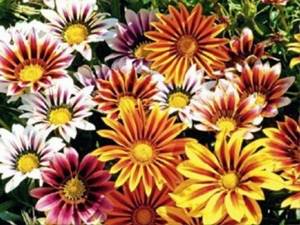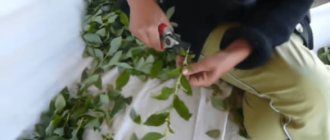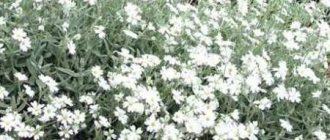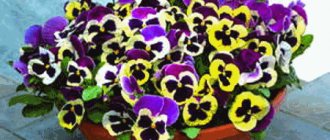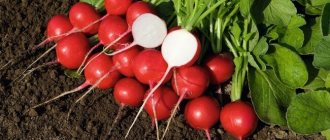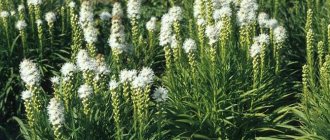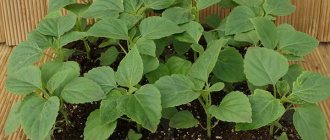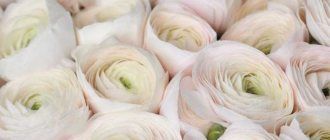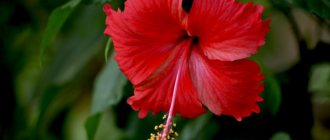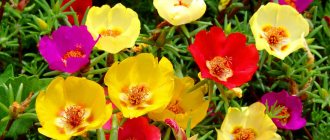This flower is increasingly found in flower beds, rocky gardens, and balconies. Gazania blooms all summer, its charming, colorful flowers have many different shades, look great in flower beds, and can be grown in containers on sunny balconies and terraces. How to care for this unique heat-loving plant so that it blooms all summer and autumn? This article describes in detail how to grow perennial gazania (gatsania) - planting and care, photos of varieties.
Description of the plant
Gazania is often called gatsaniya, variously translating the Latin name Gazania. The correct version of the name is with the letter "z". The flower received its name in honor of the scientist T. von Gas, who lived in Rome in the 15th century.
These are annual or perennial plants from the Asteraceae family, native to Africa. In nature, gazania is found in South Africa, Australia, and New Zealand. Several varieties are grown in our climate. In its natural environment, the flower grows in warm climates only up to 10 cm. Varieties grown for decorative purposes in gardens reach a height of 25-30 cm.
This is interesting! Gazania flowers open every day for several hours: from 10 a.m. to 4 p.m.

The only drawback that casts a shadow on the extraordinary beauty of gazania is that the plant tends to close its petals in damp, cloudy, bad weather. The plant needs light.
Botanical characteristics:
- Perennial or annual herbaceous plant, erect or creeping stem.
- Flowers. Gazania has inflorescences - baskets. Depending on the variety, gazania flowers come in different sizes and colors. Petals can be plain, striped or speckled. The most common petal color: yellow, less often red, white, cream, purple, pink, orange, brown. Flowers grow on short stems, forming baskets.
- The leaves are elongated, arranged in rosettes, pubescent, alternate or crowded. The plate is solid or bladed.
Gazania flowering period: from spring to late autumn!
It looks great in flower beds, rocky gardens, and slopes. Works well as a cut flower.
General information about the plant
Gazania is a short plant, reaching a height of only 30 cm. The leaves of the flower are dense, have a dark green or grayish tint, depending on the variety and soil of growth.
Leaves play an important role in the life of the plant - in hot weather they help retain the necessary moisture, and in cold weather they provide the plant with relative warmth.
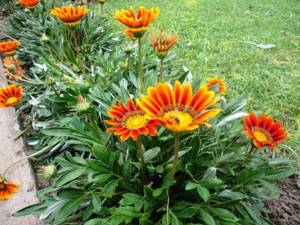
One bush can produce about 30 small but bright inflorescences (see photo of gazania). The inflorescences contain orange, yellow, and red tones, but they have one characteristic feature - a darkened zone near the middle of the flower. The flowers look very charming and charming.
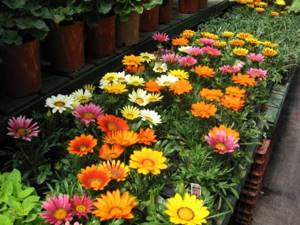
Gazania is a perennial plant, however, in our regions, where a temperate climate prevails, perennial gazania simply cannot overwinter successfully - frosts, winds and freezing of the soil destroy the roots of the plant. Therefore, gazania is most often grown as an annual crop.
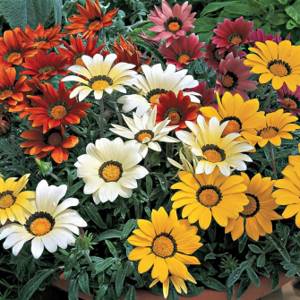
The flower basket has a diameter of 6 to 9 cm. After flowering, the hairy center of the inflorescence produces seeds, which, when fully ripe, are ready for planting.
Types and varieties
The advantage of gazania lies not only in its beautiful flowers, but also in the extraordinary variety of varieties in amazing colors and combinations. The genus Gazania includes 18 species. Let's look at the most common ones.
Harsh
The perennial gazania is harsh (lat. Gazania rigens or Gazania splendens), up to 30 cm high. The shoots are very shortened, branched, creeping below, ending in a bunch of raised leaves. The elongated leaves, 10-15 cm long, are covered with coarse hairs on the outside and white underneath. Variety G. rigens var. leucolaena has silver-green leaves on both sides, the cultivar G. rigens var. uniflora has smaller inflorescences on short pedicels.
Each shoot ends in a flower basket located on a long stalk. Second-order shoots grow from the leaf axils of the main shoot and continue to branch.
The flowers are brightly colored and resemble miniature gerberas. Blooms from early summer until the first frost. The flowers are collected in flower baskets with a diameter of 8 cm, which are opened only in full sun from 10 a.m. to 4 p.m. On cloudy, rainy days the baskets are closed.
Photo. Gazania is a bit harsh
Gazania is suitable for flower beds; it can be cultivated as a ground cover plant, grown in containers on balconies, in gazebos in well-lit places. Currently, typical forms of this species are rarely cultivated; most new ornamental varieties are hybrids of several species.
In our country, due to the climate, gazania rigidifolia is grown as an annual plant. Requires a position in full sun, fairly dry soil, sandy, well drained. Overwinters at temperatures from 5 to 10 °C.
Due to the closure of inflorescences on cloudy days, gazania has not gained much popularity; it blooms profusely only in warm and sunny years. However, recently several groups of varieties have appeared that are less sensitive to lack of light:
- daybreak,
- Kiss.
Varieties “Clear Orange”, “Clear Vanilla”, “Clear Yellow” - suitable for planting in containers and soil. The advantages of these varieties are resistance to drought, very abundant flowering throughout the summer, large inflorescences (10 cm in diameter), with flowers that open even on cloudy days. They look very impressive next to plants with silver leaves.
Varieties:
- "Gazoo" - profusely flowering plants with monochromatic flowers.

- “Big Kiss Yellow Flame” – height 25 cm, diameter of inflorescences – 10-12 cm, decorative stripes on the petals.

- "Big Kiss White Flame" - large striped flowers, shoots 25 cm high.

- "Kiss Bronze" - compact, profusely flowering variety, dark orange flowers.

- "Kiss Yellow Red Flame" - yellow-red flowers.

- "New clear day orange" - orange inflorescences.

- "New day yellow" - yellow flowers.

- "Clear vanilla" - light yellow flowers.

- "Talent" - distinguished by gray leaves.

- "Kiss white" - white inflorescences, yellow center of the flower.

- "Kiss Mahagon" - red inflorescences with a hint of mahogany.

Hybrid
Gazania × hybrida is grown as an annual under our conditions. Plants with raised shoots and flowers up to 10 cm in diameter. Blooms from June to late autumn. Ideal for flower beds and growing in containers.
Photo. Gatsania hybrid
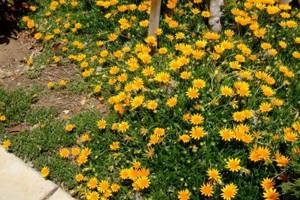
Large-flowered
Grandiflora gazanias are also annuals. Blooms from July to October. More demanding than the brilliant gazania, it is more difficult to grow. One of the most beautiful views.
Height – 30-40 cm. Used for flower beds, rock gardens, containers, window boxes. Requires fertile, well-drained, dry soil in a sunny position.
Photo. Large-flowered gatsania
Linear
Perennial linear gazania (Latin synonyms of the species - Gazania linearis, Gazania longiscapa, Gazania pinnata) - a species with chamomile-shaped flowers reaching a diameter of 8 cm. It blooms from April to late autumn, forming dense clusters. Leaves are lanceolate.
Photo. Gatsaniya linear
Krebsiana
The perennial gazania Krebsiana (lat. Gazania krebsiana) is found naturally in South Africa. Flowering lasts only a few weeks after the first rains. The showy flowers open only in bright sunlight. The leaves are snow-white on the underside.
Photo. Gatsaniya Krebsiana
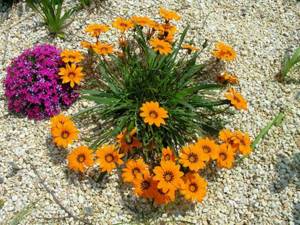
Single-flowered
Single-flowered gazania (lat. Gazania uniflora) is the lowest species, the height of the shoots reaches 10-12 cm. The leaves are oblong, with a gray tint. It blooms with white, yellow or yellow-orange flowers.
Photo. Gatsaniya single-flowered
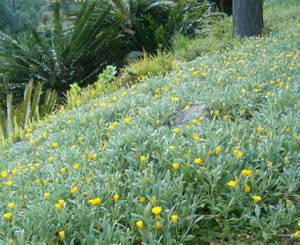
Botanical description
The annual or perennial gatsaniya is low-growing, reaching a height of no more than 30 cm. The basal leaves are collected in a rosette, the stem is either short or absent at all. The leaves are dark green or grayish-green, dense, varied in shape, with thick silvery fibers on the underside of the plate, which serve the plant as protection from cold and retain moisture in the dry season. The inflorescences are single baskets with a diameter of 5 to 9 cm, consisting of reed flowers of orange, red, yellow with dark spots at the base, forming a ring pattern around a yellow center consisting of tubular flowers. There can be about thirty-five such inflorescences on one plant. The fruit is a hairy achene with a tuft.
- What to plant next to gladioli
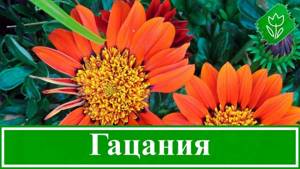
Landing
Gazania grows best in sunny, warm places. There is no flowering in shady areas. Even partial shade can prevent bud formation or result in less abundant flowering, with flowers remaining closed most of the day.
These flowers can withstand short drying of the soil, and standing water poses a danger to them, so the soil must be permeable and well-drained. Gazania rigens prefers sandy soil. The pH of the soil for planting gazania is almost unimportant. For abundant flowering, a lot of nutrients are required, so the soil must be fertile, with a high content of humus.
Potted gazanias can be planted in universal flower soil. Ideally, the soil should be light and slightly moist. Excess moisture is not favorable.
Seedlings can be grown at home from purchased or self-collected seeds, or you can buy ready-made potted seedlings. Growing from purchased seeds ensures that the seedlings will be exactly the color and shape you need. If you collect the seeds yourself, there is no guarantee that the gazanias grown from them will repeat the characteristics of the mother plant.
Before planting in the ground, seedlings purchased or grown independently must be hardened off. The seedlings are planted in the ground along with a lump of earth; they do not like injury to the root system.
The timing of planting gazania in open ground is the second half of May or later, when the likelihood of frost has passed.
Depending on the variety, seedlings are planted at a distance of 20-30 cm.
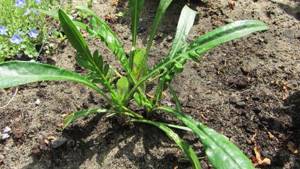
Gatsania planting technology
Many African daisies bloom only 3-4 months after sowing the seeds; therefore, they need to be planted as seedlings based on the growing season.
Growing gatsania from seeds at home
Basically, seeds for seedlings are sown between February and April. Containers must contain holes of sufficient size to prevent waterlogging of the soil.
The soil is loosened well, the seeds can be planted at a minimum distance of 3-4 cm and lightly pressed into the soil. Normally, the first shoots should appear in 2-3 weeks. It is better to drain the bottom of the pot with a 5-centimeter layer of sand and peat in equal proportions.
An important point: since all sowing work is carried out in winter, it is necessary to take care of good, constant lighting - you will need backlighting.
Important! African chamomile loves well-ventilated growing conditions - this is especially important at the stage of seedling germination, so it is advisable to constantly ventilate the room during the first weeks, otherwise mold may develop.
How to prepare gatsaniya for winter (video)
When and how to plant gatsaniya in open ground
When planting seedlings in open ground, it is important to adhere to the following rules:
- It is optimal to choose soil that is not acidified, preferably fertile and well loosened. If the soils are too poor, then it is better to immediately feed them with mineral or complex fertilizers.
- Planting is done together with a lump of earth from a pot of seedlings, so as not to injure the plant.
- It is important to have good drainage to avoid over-wetting. To do this, take humus and sand in equal proportions.
- The fundamental requirement of almost all varieties of gatsaniya is an open, sunny place (that is, even partial shade from garden trees is unacceptable).
- The optimal planting time is late April-early May, when the soil has warmed up sufficiently, frosts are not expected, and daytime temperatures are consistently above 15°C.
Advice! If the soils are highly acidified, they should be treated with ash or slaked lime before planting.
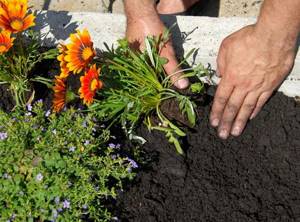
Growing and care in open ground
By providing the plant with a sunny, bright position and suitable soil, you will not have to take too much care of it, with the exception of watering and fertilizing. Growing gatsaniya in pots and containers is more difficult - proper fertilization and irrigation become very important factors. Faded inflorescences should be cut off. Removing spent flowers on a regular basis prolongs the flowering period.
Watering
Caring for gatsaniya includes regular watering. Although this plant does not tolerate wet soils, it needs to be watered during hot summers. Gazanias grown in the garden are watered only when the soil is dry. It is worth mulching the soil around the plant so that it does not dry out too much. Lack of water makes flowering weaker.
In hot, rainless weather, it is enough to water the gazania once a week. Watering should be done in the morning to allow the leaves to dry during the day. This will prevent the development of fungal diseases.
Fertilizer
Gazania is a flowering plant and should be fed regularly. Every 2 weeks it is fertilized with a multicomponent fertilizer.
When growing in pots, you can use a multi-ingredient liquid fertilizer for flowering plants every 7-14 days.
Diseases and pests
Gazania tough is resistant to diseases. But if the flower is over-watered or it rains frequently, it may become affected by root rot. With excessive moisture, the plant can be affected by:
- gray rot;
- powdery mildew;
Attention! Excessive watering can lead to yellowing of leaves, premature loss of flowers, and rotting roots. You need to wait to water until the soil dries out.
Gazania can also become a victim of pests:
- spider mite;
- thrips - leave silver spots and stripes on the leaves (then black spots appear on them);
- slugs - damage the roots of the plant;
- aphids - a plant infected with aphids grows poorly, the shoots will begin to fall off and turn yellow and wither.
If pests appear, it is necessary to treat the flowers with insecticides according to the instructions.
Wintering at home in a pot
Most gazania species are perennials, but the plants exhibit poor frost resistance, so in our climate they are grown as annuals if they are left in the garden for the winter. It is possible to save them until next season. It’s worth finding out how to preserve gatsaniya for the winter.
You can move potted plants to a bright room with a temperature of 5 to 10 degrees Celsius for the winter. To do this, bushes growing in the garden are dug up, flowering shoots are cut off, and planted in pots.

Gatsania is stored in winter as a potted plant.
In winter, home care during the dormant period includes regular soil moisture checks. The soil should not dry out excessively, so regular watering is necessary. No need to pour in too much water. In the spring, when the frosts are over, you can plant flowers in the garden.
The gazania flower is unique and extremely decorative. Although growing gazania is not the easiest thing, it is worth decorating your garden or balcony with it. It is enough to provide the flower with suitable conditions and plenty of sun to enjoy its beauty. These plants are not very popular in our climate, but deserve attention.
Gatsaniya care
Rules of care
The conditions for growing gazania, as already mentioned, are bright sunlight and well-drained soil. But, despite its love for warmth, gatsaniya can also tolerate sudden cold snaps down to -5...-7 ºC. Caring for gatsaniya in the garden consists of moderate watering, followed by loosening the soil and removing weeds and timely removal of faded inflorescences so that the plant quickly forms new buds.
Mulching the soil is also encouraged, as it allows you to retain moisture in the soil longer in the summer heat and reduces the amount of weeds on the site.
Growing gatsaniya flowers also involves fertilizing with fertilizers: if your gatsaniya grows on fertile soil, you need to feed it once a month and a half with a solution of complete mineral fertilizer at the rate of 20-25 g per square meter, but if you planted it on rocky, poor soil, then You will have to fertilize once every 2-4 weeks.
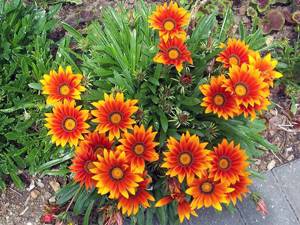
In the photo: Growing gatsania in a flowerbed
Flowering plant
Gatsania blooms from June to November, and the flowering of each basket lasts about three weeks. In the dark and in cloudy weather, the reed flowers of gatsania curl up, covering the yellow center of the tubular flowers.
- Castor bean: cultivation, planting and care
Sometimes gardeners complain that gatsaniya does not want to bloom. This may be due to insufficient lighting, excessive watering, or transplanting seedlings into open ground too late. Try not to violate the agrotechnical requirements of gatsaniya, and it will bloom on time and abundantly.
Pests and diseases
Anyone who has grown gatsaniya will tell you that it does not get sick. But if growing conditions are unfavorable for the plant, it weakens, and then it can be affected by gray rot. You will have to remove diseased specimens and treat the remaining plants with Fitosporin.
Among the insects that harm gatsania are snails, aphids and spider mites. Snails need to be collected by hand, and insects are destroyed with insecticides: aphids - Fitoverm, Akarin, Inta-vir, and spider mites - Actellik, Fufanon or Ditox.
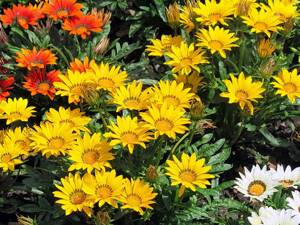
In the photo: A combination of different varieties of gatsanias in a flowerbed
Reproduction
Gazania can be propagated in several ways:
- seeds,
- layering.
Collection and storage of seeds
Seeds can be collected from faded inflorescences. It is better to collect the seeds in the morning, on a sunny day, when they are dry from the morning dew, but not yet overdried by the sun.
How to collect gatsaniya seeds:
- The seed heads are cut off from the plant when they turn brown.
- The collected flower heads are laid out on a fine mesh and kept in a cool, dry place with good air circulation for several weeks to dry completely.
- Then you need to rub the flower heads over a piece of paper to separate the seeds from fluff and other debris.
- The seeds are placed in an airtight container and the box is labeled with the date of collection, information about the parent plant, and any other relevant information.
Store seeds in a cool, dry place. This will help save the gazania seeds until next year.
Growing seedlings from seeds
Gazania can be propagated by sowing seeds. Growing seedlings takes 1-1.5 months.
When to plant gatsaniya seeds? In February or March, gazania seeds are sown in boxes stored at home or in a greenhouse. Regularly lightly spray the soil with water, being careful not to dislodge the seeds.
Conditions for growing gatsania seedlings from seeds at home:
- Soil with a pH of 5.5–6.5, prepared from peat and compost soil.
- The better the access to light, the stronger the branching and compactness of the plants.
- Plants will germinate in 10-14 days. At 21 °C germination lasts 10–12 days. After 7-10 days, if the seedlings are growing quickly, the temperature should be lowered to 16 °C.
- Gazania seedlings require more frequent watering in the early stages than well-established mature plants. Seedlings need to be watered systematically, but not too much, preferably in the morning, otherwise gazania is easily attacked by gray rot.
Sowing gazania seeds in open ground can cause the plant to begin to bloom much later.
The seeds are too small to be sown at regular intervals; you can mix them with sand to sown fairly evenly.
When the seedlings in the boxes grow up and the first true leaves appear, the seedlings should be planted in pots. If the seeds were sown in small cell seedling trays, the plants are transplanted into pots with a diameter of 11–12 cm approximately 4 weeks after germination.
Photo. Gatsania seedlings after picking into separate pots

Varieties from the Gazu group should be grown in large containers to allow the plants to grow vigorously.
The seedlings are transplanted into open ground in the second half of May, when there is no risk of night frosts. Before planting, seedlings need to be hardened - taken out into the open air and sun, first for 10-15 minutes, gradually increasing the hardening period. This is done so that indoor plants gradually get used to outdoor conditions and do not get burned when transplanted into flower beds.
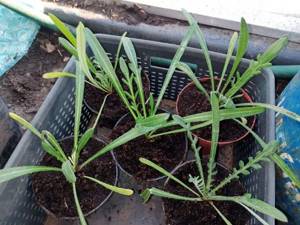
By layering
Gazania can be propagated by horizontal layering.
Work progress:
- The soil at the point of contact of the shoots needs to be loosened.
- The shoot, which is part of the mother plant, is bent to the side, leaves and side shoots are broken off. You can secure it in the ground with a hook or pin.
- Cover the shoot with soil.
Over time, the shoot will take root and become detachable. This way a new plant is obtained. In our climate this is not an easy path, so it is better to propagate gazania by sowing seeds.
Gazania seedlings
To make sure you get enough plants, you can try growing gazania seedlings. To do this, you should purchase deep containers for planting - the roots of the plant love space. The best time to start sowing seeds for seedlings is the beginning of March.
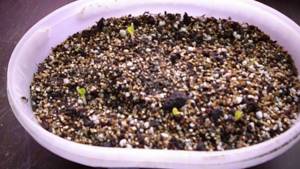
The plant prefers light, permeable soil with medium acidity. Seeds should be sown rarely, keeping a distance of 3-4 cm between them. Gazania seeds should simply be placed on the soil and lightly sprinkled with soil, otherwise they may not germinate.
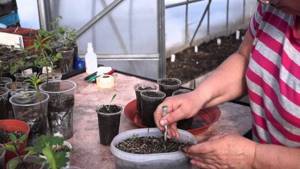
Use a spray bottle to moisten the soil once a day. It is better to cover the container with film. After watering, the film should be opened slightly for 10-15 minutes. The temperature in the room where the container is located should be between 18-22 degrees Celsius.
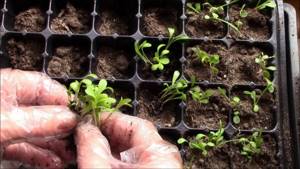
Under good watering and care conditions, the first shoots appear in 10-12 days. It is necessary to grow the seedlings until 4 full leaves open, and 6-8 days before transferring the seedlings to open ground, you must begin to harden the plants.
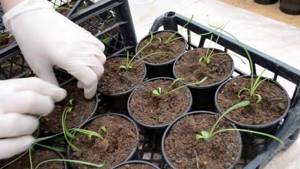
To do this, you should take the container with seedlings outside every day - first for several hours, gradually increasing the interval to 10-12 hours. You should ensure that the seedlings are not exposed to a draft.
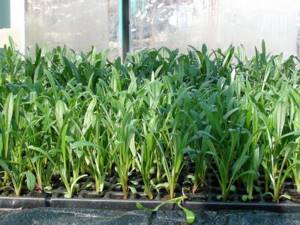
Growing gazania using seedlings allows you to obtain healthy and high-quality planting material, which in the future will definitely decorate any corner of the garden.
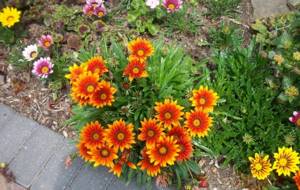
Use in landscape design
Gazania is a beautiful flowering plant; it is planted in containers, pots, boxes, flower beds (especially dwarf gazania). The flower effectively decorates gardens, terraces, and balconies.

Flowers look best in small beds where they can act as a border. Look great with other colors. You can plant them next to sunny walls, buildings, rockeries. They require warmth and a sunny position, which are critical for successful cultivation.
Gazanias can also be used for cut flowers and bouquets.
Photo. Ground cover varieties that beautifully cover slopes and other sunny areas in the garden look interesting.
Gazania is a small plant with enormous decorative value. The flower has excellent resistance to heat and drought. Thanks to its wide range of colors, it will charm any place where it is planted. This unique beauty decorates flower beds and rock gardens and adds style to balconies.
Caring for gazania in the garden
Like other members of the Asteraceae family, gazania is a very unpretentious crop. Caring for her in the garden is a pleasure.
African chamomile should be protected from excess moisture; maintain moderate irrigation once a week. In hot weather, the watering regime is adjusted by watering the garden flower more often. The next day, loosen the soil around the bush and sprinkle the surface with peat chips. Mulch will prevent rapid evaporation of moisture and protect seedlings from the violent growth of weeds.
To stimulate the formation of new buds, remove faded inflorescences in a timely manner. This will increase the decorative effect and save the energy of the African guest, since she will spend a lot of resources on ripening the seeds. Timely weeding will preserve the presentable appearance of the flower garden and protect it from pest attacks.
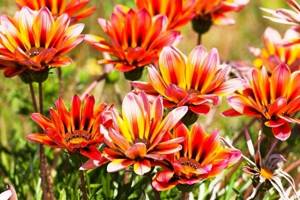
Depending on the type of soil, fertilizers are applied every 2-6 weeks. If the soil in the chosen location is well fertilized, it is enough to feed the plant once every 1.5 months. Poor soils are fertilized every 2-4 weeks.
On a note! The rate of application of complete mineral fertilizer is 20 grams per square meter.
From mid-summer you can propagate the flower by cuttings. Compared to seed propagation, this method is superior because it completely preserves varietal characteristics. Side shoots are rooted in a mixture of peat and sand, kept at moderate humidity and a temperature not higher than 18-20⁰C. Pre-treatment of cuttings with growth stimulants will have a positive effect on rooting. After developing their own root system, the cuttings can be planted in a permanent place.
Description of popular varieties of gazania, features of growing by seedling method
Breeding gatsanias through seedlings is the most productive growing method. Breeders have created many spectacular varieties of African guest; consider descriptions and recommendations for growing the most popular cultivars.
Gatsaniya hybrid - growing from seeds
Varieties of hybrid origin are enjoying unprecedented success. Their popularity is due to long flowering, high decorativeness, resistance to diseases and environmental conditions. Cultivation of most varieties is similar to the process described above. Let us only remind you that seed material will have to be purchased annually in a specialized store or the flower will have to be renewed using the cutting method.

Gatsania Triad from seeds
The Triad varietal mixture reaches a height of 20-25 cm, forms dense flower mats, densely strewn with bright baskets. The basal rosette of leaves is well developed and harmonizes with the flowers. Chamomile petals are colored in various shades and have a dark eye at the bottom. The corolla, 5-6 cm in diameter, opens wide only in sunny weather. The triad will decorate the border or become an effective filling for the border. Silky petals look organic among stones - in a rock garden or on an alpine hill.
Important! When growing the Triad variety mixture, it is important to take into account that abundant formation of buds is possible only in the hot summer. Shading on the site is unacceptable.

Sowing work is carried out in March-April or seeds are sown in open ground from mid-May. Care includes the following items:
- moderate watering;
- applying fertilizers 2 times a month;
- loosening;
- weeding;
- mulching.
In winter it grows well indoors. You can cultivate this variety at home all year round and decorate your balcony with a scattering of colorful inflorescences.
Gatsaniya Muse - subtleties of cultivation
Muse is another magnificent variety mixture, distinguished by its two-tone petals of contrasting color. The bright yellow core is trimmed with dark eyes in the lower part of the corolla. The height of the bushes is 20-30 cm, budding is abundant and long-lasting. The diameter of the corolla reaches 5-6 cm. Muse is suitable for cultivation at home. Seedlings are grown for the flower bed. The culture is sensitive to lack of light; it requires a well-lit area with drained soil.
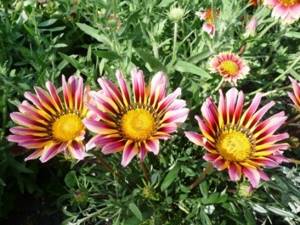
Gazania Sunlight from Seeds
The Sunlight mixture produced flowers of bright colors. The mix contains seeds of monochromatic flowers from snow-white to purple or a combination of these colors. Satin corollas will harmoniously fit into any type of flower garden. Height is 20-25 cm, the inflorescences are large, up to 10 cm in diameter. The seed propagation method from its own seed is impossible - the flowers are sterile.
Know! The variety mixture Sunlight is unpretentious to the soil and agricultural background, drought-resistant, mature bushes easily tolerate frost.
The culture needs warmth and bright sunlight and is grown by seedlings. For good growth, light, fertile soil is required. Young shoots are grown in individual containers to protect the root system from injury during the transplantation process. Sowing activities are carried out in March; bright corollas delight the eye from mid-June until the first frost.
Gazania Sunlight
An excellent solution for cultivation on the balcony. No less interesting are other varieties of the African guest - Daybreck, Kiss, Ministar, Talent, New Day.
